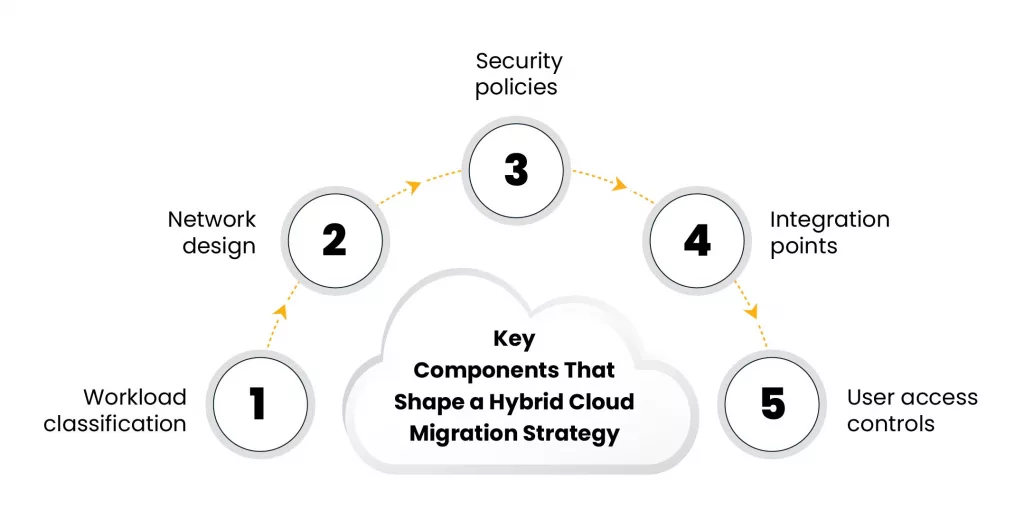As technology continues to shape how businesses run, many companies are stepping back to reassess their current infrastructure. They want to know if what they have today can keep up with their daily needs — and still scale when things grow. In many cases, this review brings up the same issue: the setup lacks flexibility. It can’t fully support newer workloads without risking the systems already in place.
That’s where the hybrid cloud migration strategy comes in. More businesses are turning to this model because it offers a practical way to move forward. It gives them the speed and reach of public cloud while letting them keep certain systems on-premises or in private environments — where they need more control. With this approach, they can modernize in stages. It also gives them room to meet security rules, performance goals, and internal constraints without forcing everything to change at once.
But choosing a hybrid is just the start. To make it work, there’s a lot to think through — from technical planning to team readiness. In this blog, we’ll break down the key factors businesses need to get right before, during, and after shifting to a hybrid setup.
Why Hybrid is a Strategic Fit for Many Businesses
A hybrid cloud allows businesses to run some workloads in the cloud while keeping others in-house. This is especially useful in industries where data sensitivity or infrastructure legacy plays a role.
For many companies, shifting everything to the public cloud isn’t practical. Teams need to support legacy systems, manage regulatory requirements, and maintain predictable environments. These needs make hybrid setups an operationally sound option for cloud migration for enterprises.
Hybrid setups give organizations a measured way to modernize. Teams can move in stages, limit risk exposure, and stay within budget guardrails.
Key Components That Shape a Hybrid Cloud Migration Strategy

Planning a hybrid cloud migration strategy begins with understanding how different parts of your environment need to work together. It’s not just about moving applications or data. There are several valuable building blocks that need attention.
- Workload classification: Decide which applications and data sets must stay on-premises and which can run in the cloud.
- Network design: Plan out network routing, access controls, and latency boundaries.
- Security policies: Make sure all components comply with organizational standards.
- Integration points: Many legacy apps need middleware or APIs to connect with cloud-native services.
- User access controls: Authentication must be seamless across environments, with central identity providers where possible.
These components lay the foundation. Without addressing them early, it becomes harder to fix issues after migration begins.
Planning: What Makes a Hybrid Cloud Migration Work or Fail
A lot of hybrid migrations face trouble not because of technical tools but due to planning gaps. Leaders often underestimate how much coordination is required across departments.
Here are specific areas that can either set the migration up for success or create delays:
- Data governance: Make sure your data is classified clearly, public, confidential, restricted, and handled accordingly across environments.
- Dependency mapping: Identify application dependencies before moving anything. One broken link can cause downtime across teams.
- Access control consistency: Employees should not face login issues when switching from on-prem to cloud-hosted apps.
- Cloud tagging strategy: Apply clear tags from day one for reporting. Also, apply tags for cost control and audits.
Without structured planning, the migration can turn into a series of patch jobs. For many cloud migration for enterprise projects, this is where most blockers come from.
The Role of Multi-Cloud in a Hybrid Setup
Hybrid and multi-cloud often overlap. Some businesses operate private infrastructure alongside more than one public cloud provider. This structure helps meet vendor diversity goals or specific workload compatibility needs.
A well-structured multi-cloud migration strategy focuses on how to balance operational control, vendor contracts, and user experience across platforms. Each cloud provider has its own tools, billing logic, and limitations. In a hybrid setup, this becomes even more complex.
Teams must build a framework that handles:
- Centralized monitoring across all platforms
- Shared secrets and authentication tokens
- Uniform deployment standards
- Cloud-specific billing reconciliations
For businesses going hybrid with more than one public vendor, it’s important to treat the multi-cloud migration strategy as a separate stream within the overall migration plan.
Migration Approaches for Hybrid Cloud
Every application and service will have a different path to migration. Some can be moved quickly, while others need a major redesign. Here’s a breakdown of key approaches:
| Migration Approach | When to Use It | Risk Level |
| Rehosting (Lift-and-Shift) | For VMs and workloads that run as-is | Low to Medium |
| Refactoring | Apps that benefit from code changes | Medium |
| Replatforming | Apps that need updates to run in cloud | Medium |
| Rearchitecting | For building cloud-native applications | High |
This table can help identify the right approach based on available resources and long-term goals. Every stage should be aligned to your hybrid cloud migration strategy and compliance posture.
In cases where multiple clouds are involved, the multi-cloud migration strategy must account for the added complexity of toolchains, services, and API management.
Security & Compliance Planning
Security is one of the most critical components of any hybrid cloud migration strategy. Not everything can be protected the same way in a hybrid setup. There are more edges, more endpoints, and more hands involved.
Key planning points:
- Encryption: Use customer-managed keys when possible, with different keys for each environment.
- IAM: Identity and access management should be centralized, with role-based access control clearly defined.
- Network segmentation: Separate environments by function, sensitivity, or team, and restrict lateral movement.
- Audit logs: Retain consistent and timestamped logs across environments, with central archiving for compliance checks.
When dealing with cloud migration for enterprises, it’s crucial to document every policy adjustment and have a clear chain of authority for security decisions.
Tools and Technologies Used to Support Hybrid Cloud
Azure Arc: It helps manage Windows and Linux servers across on-prem, Azure, and other clouds.
- AWS Outposts: It allows running AWS services locally in your data center.
- Google Anthos: It offers a consistent platform across cloud and on-premises environments.
- VMware Tanzu: It is useful for managing Kubernetes in hybrid environments.
These tools can support different elements of your hybrid cloud migration strategy, depending on your stack and team capability.
Common Gaps Businesses Face Mid-Migration
During migration, unexpected issues are common. Below are some of them:
- Incomplete inventory of apps and services
- Overlooked system dependencies
- Broken integrations during cutover
- Lack of rollback plans
- Conflicts between cloud and on-prem naming conventions
- Cost tracking gaps due to untagged resources
Keeping a clear runbook helps avoid mid-migration confusion. A strong hybrid cloud migration strategy will document fallback plans and assign owners for each critical process.
Why Partnering is Often the Smarter Move
Executing a hybrid migration in-house is possible, but it takes specialized knowledge and bandwidth that many teams don’t have. Businesses that have succeeded with hybrid models often work with trusted partners.
Partnering gives you:
- Migration architects with proven experience
- Structured planning and playbooks already tested across industries
- Access to certified tools and automation pipelines
- Reduced internal load on your infrastructure and DevOps teams
Partners can help design both your hybrid cloud migration strategy and multi-cloud migration strategy, while reducing trial-and-error delays. With the right partner, businesses get to their desired state faster, and with fewer surprises.
Final Thoughts and What Comes Next
A hybrid cloud migration strategy requires more than technical lift. It needs planning that touches every part of your business, from security to compliance to workforce capability.
If your teams are already considering a hybrid or multi-cloud migration strategy, now is the right time for the following:
- Review the roadmap
- Build the checklists
- Consider the support you will need
The migration journey is smoother when you’ve mapped every checkpoint before taking the first step.











